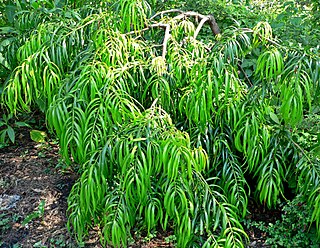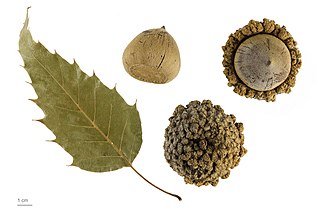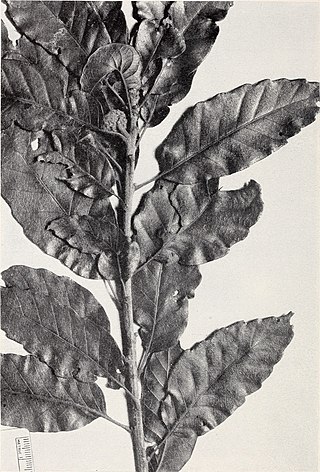
Magnolia macrophylla, the bigleaf magnolia, is a deciduous magnolia native to the southeastern United States and eastern Mexico. This species boasts the largest simple leaf and single flower of any native plant in North America.
Magnolia guatemalensis is a tree found in the highlands and mountains of Chiapas, Guatemala, El Salvador, and Honduras. It is considered an indicator species of the cloud forest.

The Sierra de Los Tuxtlas are a volcanic belt and mountain range along the southeastern Veracruz Gulf coast in Eastern Mexico. The Los Tuxtlas Biosphere Reserve includes the coastal and higher elevations of the Sierra de Los Tuxtlas.

Podocarpus matudae is a species of conifer in the family Podocarpaceae. It is found in Guatemala, El Salvador, Honduras and Mexico.

Magnolia dealbata is a species of flowering plant in the family Magnoliaceae, native to Mexico. It is known commonly as the cloudforest magnolia and eloxochitl. It is sometimes considered to be a subspecies of Magnolia macrophylla, which is otherwise native to the southeastern United States.
Magnolia iltisiana is a species of plant in the family Magnoliaceae. It is endemic to Mexico. Common names include ahuatoso and yoloxochitl.

Magnolia polyhypsophylla is a species of plant in the family Magnoliaceae. It is endemic to Colombia. It is known commonly as almanegra de ventanas.
Magnolia schiedeana is a species of flowering plant in the family Magnoliaceae. It is endemic to Mexico, where it occurs along the slopes of the Gulf of Mexico.
Magnolia yoroconte is a species of tree in the family Magnoliaceae. It is found in Guatemala, Belize and Honduras.

Quercus skinneri is a species of oak. It is found in Mexico, Guatemala, Honduras, and El Salvador. It is threatened by habitat loss.

Magnolia portoricensis is a tree of the Caribbean region. Its vernacular names include jagüilla and Puerto Rico magnolia. It is native to Puerto Rico and it is found in the Toro Negro State Forest. It is an endangered tree and endemic to Puerto Rico. It is a dicot and a part of the family Magnoliaceae. It is an uncommon tree, found primarily in the central and western mountains at 500 to 925 m above sea level.
Magnolia sulawesiana is a large evergreen tree of the family Magnoliaceae that grows in tropical montane forests on the Indonesian island of Sulawesi.

Quercus corrugata is a species of oak found in Central America and Mexico.

Magnolia pterocarpa is a species of tree in the Magnoliaceae family that grows in South Asia.
Magnolia mexicana, the Mexican magnolia, is a species of magnolia that is found in parts of Mexico, Guatemala and Honduras. The flower is known in parts of Mexico as yolloxochitl, an Aztec word that loosely translates to heart-shaped flower. The Mexican magnolia, often described as having a strong beautiful scent, has been used throughout the years for its medicinal properties, as it is said to have similar compounds to that of the Digitalis medication.
Magnolia nuevoleonensis is a species of flowering plant in the family Magnoliaceae. It is native to the Sierra Madre Oriental of Nuevo León state in northeastern Mexico.
Magnolia rzedowskiana is a species of flowering plant in the family Magnoliaceae. It is native to the Sierra Madre Oriental of San Luis Potosí, Querétaro, and Hidalgo states in eastern Mexico.
Magnolia vovidesii is a species of flowering plant in the family Magnoliaceae. It is native to the Sierra Madre Oriental of Veracruz state in eastern Mexico.
Magnolia pedrazae is a species of flowering plant in the family Magnoliaceae. It is endemic to the Sierra Madre Oriental of eastern Mexico.
Magnolia vazquezii is a species of flowering plant in the family Magnoliaceae. It is endemic to the Sierra Madre del Sur of Guerrero state in southern Mexico.









